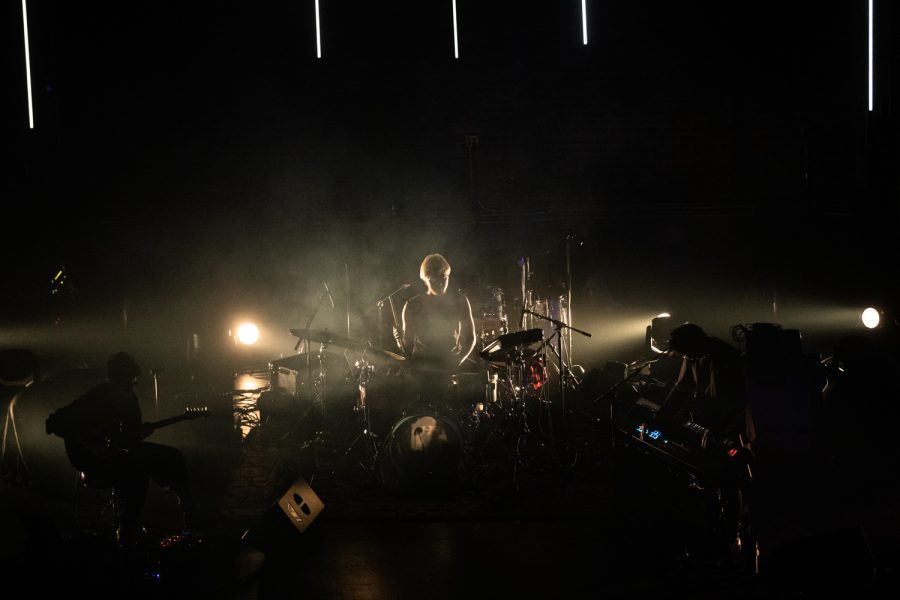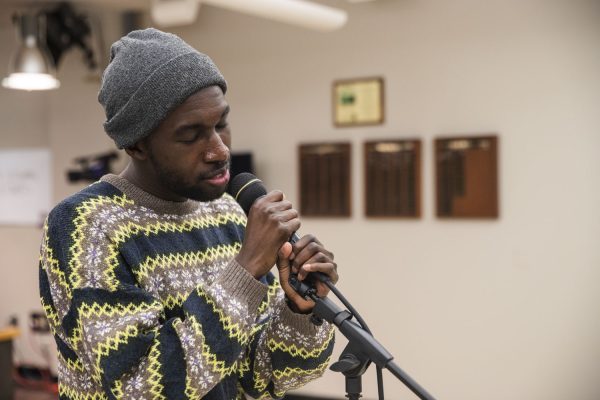New York band Son Lux plays with the senses through experimental sound
Son Lux is an experimental band featuring Ryan Lott, Rafiq Bhatia, and Ian Chang. They performed at the Englert Theatre last Friday, April 8, for the Mission Creek Festival.
Son Lux plays at the Englert Theatre as part of the Mission Creek Festival in Iowa City on Friday, April 8, 2022.
April 14, 2022
The lights dim and fog emerges, before a single spotlight back-lights the drummer, a halo of light surrounding him. The effect matches the haunting music that possesses the crowd, as the spotlight switches from member to member of the band.
Those in attendance at the Englert Theatre on April 8 for the Mission Creek Festival no doubt remember the performance of Son Lux, an experimental band started in New York, consisting of lead singer and keyboardist Ryan Lott, guitarist Rafiq Bhatia, and drummer Ian Chang.
On the Englert’s stage were the glowing figures producing their captivating music, and below them, a room of people nodding in time to the eerily beautiful music — Son Lux’s experimental methods produced a truly mesmerizing performance.
Son Lux is the brainchild of Lott, who previously composed the movie score for John Green’s Paper Towns. Bhatia is a music producer and composer who considers science when curating the band’s sound. Chang is also a producer and composer as well as the band’s drummer.
RELATED: Mission Creek Festival returns to rock Iowa City
Son Lux’s creative process begins with experimenting in the studio, brainstorming, and creating any bits of music that come to mind. Next, they “mine” the audio, or begin building songs around scraps of sound that they are inspired by.
“The analogy we like to use for [mining audio] is like, we’re designing a house around a specific chair, rather than like building the house and then filling it with furniture,” Chang said.
Sometimes they choose to write a song around what Lott comes up with. No matter what, Change said, they are concerned with the melody, the sound of the music, and the effect it has on the listener, first and foremost.
Bhatia said he recently became obsessed with the work of James Turrell, an American artist known best for his work with light and movement.
“He works with light, but he considers the human perception of light to be his medium, as opposed to the light itself being the medium for his art,” Bhatia said. “In his work, a lot of times he’ll use dramatically different techniques to achieve almost an identical result.”
Bhatia’s recent exploration into the science of light informed the band’s skillful lighting choices, which gave each member a spotlight and a halo effect at different times during their time on the Englert’s stage, and further elevated the performance.
“We’re really concerned with the listener’s sort of perception of the music, as what the music is — it’s not the music in a vacuum,” Bhatia said. “It’s how we, as human beings, the way that our ears are tuned affects the way that we perceive different audio frequencies.”
He noted examples such as how the human ear is specially tuned for the sound of babies crying and thunderstorms, and said listening to music is similar.
“There’s also a kind of empathy that happens when we experience music, where we imagine, you know, ‘what human action or otherwise, what action was required to make a certain sound?’” Bhatia said. “That’s something that everybody’s brains do, and you can play with that perception in a way where you take sounds that may, on their face, be really alien.”
Bhatia cited electronic music as a way to do this, but noted that it is worth pairing something “foreign” like electronic sound with something familiar to best play with the listener’s senses.
“Playing with the person’s perception of like, okay, now it feels real and now it doesn’t is something that I think we’re all very concerned with and excited by,” Bhatia said.













